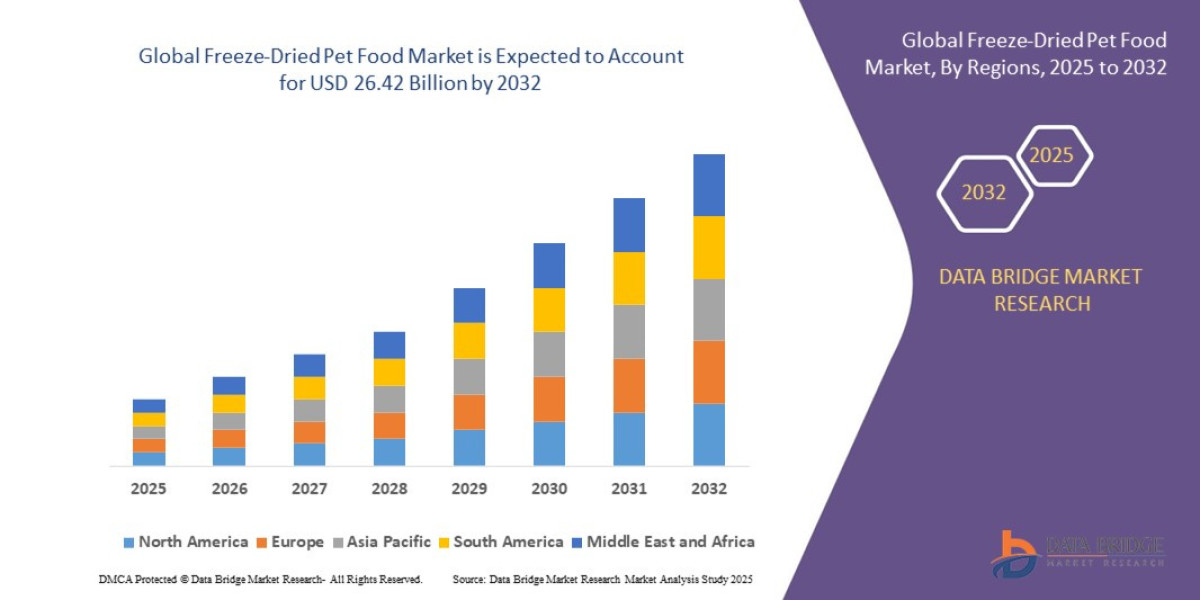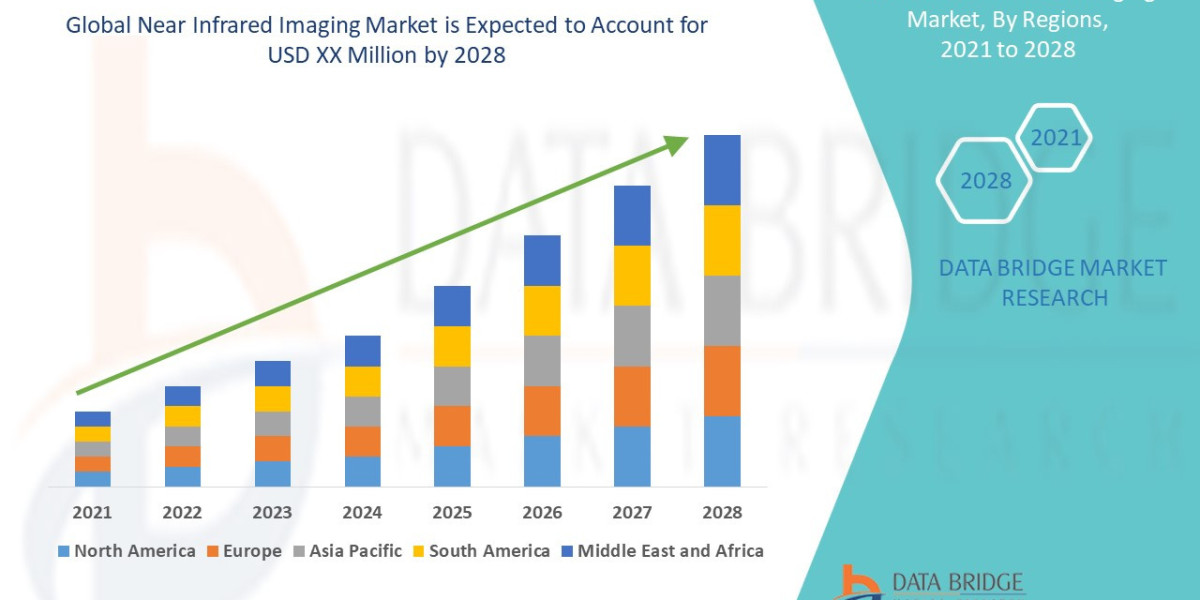Executive Summary
- The global freeze-dried pet food market size was valued at USD 18.44 billion in 2024 and is expected to reach USD 26.42 billion by 2032, at a CAGR of4.60% during the forecast period
Market Overview
Freeze-dried pet food is manufactured using lyophilization, a sophisticated process involving freezing the raw material and then reducing the surrounding pressure to allow the frozen water to sublimate (turn directly from ice to vapor). This process removes approximately 98% of the moisture content without using heat, thus preserving the nutritional integrity, flavor, and texture of the original raw ingredients better than traditional cooking or dehydration methods.
Key Market Segments by Product Type:
Freeze-Dried Complete & Balanced Meals: The highest value segment, consisting of entire meals (meat, organs, bone, vegetables) designed for sole feeding. These offer the highest margins but require stringent formulation and safety testing.
Freeze-Dried Treats and Mix-ins: The entry-point segment, characterized by single-ingredient products (e.g., chicken liver, salmon). These are highly popular for training and as palatability enhancers used to top kibble, offering an affordable way for owners to introduce raw nutrition.
Raw-Coated Kibble/Hybrid Formulations: The largest volume segment. This involves coating traditional dry kibble pellets with a pulverized layer of freeze-dried raw meat/organ mixture. It offers improved palatability and marketing advantages while mitigating the high cost of a 100% freeze-dried diet.
Key Market Drivers:
Humanization of Pets: Owners increasingly view their pets as family members and demand human-grade food standards, prioritizing 'clean labels,' identifiable ingredients, and minimal processing.
Convenience of Raw: Freeze-dried products offer the nutritional benefits often associated with raw food (high protein, enzyme retention) without the freezer space requirements, preparation time, and potential mess of traditional frozen raw diets.
Veterinary Endorsement (Niche): While traditional raw diets face veterinary skepticism regarding safety, freeze-dried options are sometimes endorsed for specific use cases (e.g., highly palatable toppers for sick or finicky eaters, or specialized elimination diets).
Food Safety Perception: Due to the dry nature and use of safety protocols (like High-Pressure Processing, or HPP, before drying), freeze-dried is generally perceived by consumers as safer than home-prepared raw food.
Current Market Dynamics:
The market is currently fragmented, with niche, high-end raw brands dominating the category. Major CPG players are actively entering the market through acquisition or by launching competitive hybrid formulations. The competitive focus is shifting from simple protein content to sustainability, ethical sourcing, and verification of minimal processing (e.g., non-GMO, organic).
Market Size & Forecast
- The global freeze-dried pet food market size was valued at USD 18.44 billion in 2024 and is expected to reach USD 26.42 billion by 2032, at a CAGR of4.60% during the forecast period
For More Information visit https://www.databridgemarketresearch.com/reports/global-freeze-dried-pet-food-market
Key Trends & Innovations
Innovation is focused on maintaining nutritional superiority while addressing supply chain complexity and consumer ethics.
1. Hybrid and Dual-Texture Formulations: The evolution of raw-coated kibble continues, with innovations introducing dual textures (e.g., soft freeze-dried pieces mixed into hard kibble) to enhance palatability and offer a more varied sensory experience for pets. This mitigates the high cost of 100% freeze-dried diets, making them accessible to a wider consumer base.
2. Functional and Novel Ingredients: Aligning with human supplement trends, freeze-dried products are incorporating functional ingredients aimed at specific health outcomes:
Joint and Mobility: High concentrations of green-lipped mussel (naturally freeze-dried), collagen peptides, and curcumin.
Digestive Health: Inclusion of targeted postbiotics and novel fiber sources.
Adaptogens: Ingredients like Reishi mushrooms and Ashwagandha for stress management.
3. Sustainable and Alternative Proteins (Insect and Plant-Based): Manufacturers are exploring freeze-drying of sustainable, novel proteins to address resource constraints and pet allergies. Insect protein (Black Soldier Fly Larvae, Crickets) is an ideal candidate for freeze-drying as it is hypoallergenic, highly nutritious, and easily processed, positioning it as a future staple, especially in European markets.
4. Advanced Safety Protocols (HPP): To eliminate the risk of pathogens associated with raw meat, many manufacturers now implement High-Pressure Processing (HPP). This non-thermal pasteurization technique is applied before lyophilization to kill harmful bacteria like Salmonella and E. coli while retaining the raw nutrient profile, providing a critical competitive edge in food safety.
Competitive Landscape
The competitive environment is characterized by large specialty brands that pioneered the category and aggressive interest from multinational CPG conglomerates seeking premium market share.
Major Players and Strategic Positioning:
Stella & Chewy's (U.S.): A market pioneer with strong brand identity and deep penetration in independent pet retail. Strategy focuses on a full portfolio of 100% freeze-dried meals, coated kibble, and treats, emphasizing ethical sourcing.
Instinct Pet Food (U.S., owned by Agropur): Known for its 'Raw Boost' coated kibble line, effectively bridging the gap between mass-market consumers and the raw segment. Strategy is built on leveraging CPG scale for marketing and distribution.
K9 Natural / Feline Natural (New Zealand): Dominant in the high-quality international export market, leveraging New Zealand's perception of clean, sustainable sourcing (grass-fed lamb, venison).
Acquisition Targets: Many smaller, specialized regional brands that own their manufacturing are prime M&A targets for global giants like Mars, Nestlé Purina, and General Mills, who seek to instantly gain capability and market share in the premium space.
Competitive Strategies:
Vertical Integration: Companies that own and operate their own freeze-drying facilities gain significant competitive advantage through cost control, quality assurance, and production flexibility.
Education and Retail Partnership: Since the category requires higher consumer education, successful brands invest heavily in training independent pet store staff to act as informed advocates for their premium products.
Clean Room Manufacturing: Competing on validated safety standards, showcasing dedicated, pharmaceutical-grade 'clean rooms' for processing to mitigate concerns over raw ingredient handling and cross-contamination.
Regional Insights
Market maturity directly correlates with disposable income and the established raw feeding culture in each region.
North America (U.S. and Canada)
Dominant Market: Holds the largest revenue share globally. The market is saturated with high-end brands, and competition focuses on niche ingredient sourcing and functional innovation.
Strategic Focus: Deepening B2B channels through veterinary partnerships and accelerating e-commerce subscription models (high Average Order Value - AOV).
Western Europe (Germany, UK, Nordic)
High Growth Potential: Experiencing rapid adoption, driven by stringent food safety standards and a strong consumer movement toward 'natural' and local foods.
Strategic Focus: Emphasis on sustainable protein sources (including insect-based) and regulatory compliance with strict EU pet food labeling and ingredient regulations.
Asia Pacific (APAC)
Emerging Opportunity: Rapidly growing in high-wealth urban centers (Seoul, Tokyo, Sydney). Pet ownership is increasing, and owners in these regions have high disposable income and value imported, Western-style premium brands.
Strategic Focus: Investing in cold-chain logistics for initial storage and emphasizing shelf-stability for easy storage in small apartments. Focus on the underserved cat segment where freeze-dried treats are highly popular.
Challenges & Risks
The high cost structure and reliance on raw meat processing present unique operational barriers.
1. High Capital Expenditure (CapEx) and Operational Costs: Lyophilization equipment is extremely expensive to purchase and requires massive, consistent energy consumption to operate, leading to high production costs that translate directly to premium pricing and limited scalability compared to kibble.
2. Raw Ingredient Sourcing and Quality: Maintaining the quality and traceability of raw, human-grade meat and specialty ingredients (e.g., organs, bone) on a massive, industrial scale is challenging. Any lapse in raw material quality directly impacts the final product's integrity and safety.
3. Oxidation Risk (Rancidity): Although freeze-drying removes water, the high-fat content inherent in raw meats remains susceptible to oxidation (rancidity), a critical quality degradation risk. This necessitates highly sophisticated packaging (barrier films, nitrogen flushing) and careful management of fat content.
4. Consumer Education and Confusion: Consumers often confuse freeze-dried with less expensive, lower-quality processing methods like air-drying or dehydration. This lack of clear differentiation can dilute the premium message and requires extensive, costly marketing to overcome.
Opportunities & Strategic Recommendations
The path to sustained market leadership lies in technological investment, channel specialization, and strategic focus on the cat market.
For Manufacturers (Brands and Co-packers):
Vertical Integration and Efficiency: Prioritize securing supply chains and investing in proprietary, energy-efficient lyophilization technology to lower unit costs and protect margins. Offer co-packing services to smaller brands to maximize utilization rates of expensive machinery.
Target the Feline Segment: The cat food market is significantly underserved by freeze-dried complete meals, presenting a major, high-value growth opportunity. Cats are obligate carnivores, making freeze-dried, meat-intensive formulations highly suitable.
Digital-First Subscription Models: Freeze-dried food is ideal for subscription services due to its high price point and low physical density (low shipping cost relative to value). Focus digital strategy on maximizing repeat purchase rates and locking in Lifetime Customer Value (LTV).
For Investors and Technology Providers:
Invest in Processing Tech: Seek investment opportunities in companies developing advanced non-thermal pathogen inactivation technology (like HPP) and superior packaging science specific to fat oxidation control in freeze-dried matrices.
Clinical/Therapeutic Niche: Partner with veterinary specialists to develop and clinically validate freeze-dried prescription diets for common conditions (e.g., highly digestible protein for GI sensitivity, or low-purine diets), securing access to the high-margin, professional channel.
Browse More Reports:
Global Small Molecule Sterile Injectable Drugs Market
Europe IoT Node and Gateway Market
Global Ophthalmic Anesthetic Drugs Market
Global Sustainable Aviation Fuel Market
North America Acute Lymphocytic/Lymphoblastic Leukemia (ALL) Diagnostics Market
Global Polymeric Nanoparticles Market
Global Acrylic Adhesives Market
Global Washing Appliances Market
Global Public Key Infrastructure (PKI) Market
Global GPS (Global Positioning System) Tracking System Market
North America Unmanned Ground Vehicle Market
North America Biometrics in Government Market
Global Gas Turbine Services Market
Global Energy Efficient Motor Market
Global Two Terminal Impact (Impact Ionization Avalanche Transit-Time) Diode Market
Global Antivirus Software Market
Middle East and Africa Polyimide films Market
Global Gene Expression Analysis Market
Global Genetic Testing Market
Global Food Ingredient Market
Global Ultra Soft Exoskeleton Market
Global Supercapacitor Market
Global Industrial Nitrogen Market
Global Mono-Material Packaging Market
Global Hematology Drugs Market
Global Polyethylene Implants Market
Global Dental Devices and Consumables Market
Global Ear Plugs and Bands Market
North America Commercial Cleaning Equipment Market
Global Rice Husk Ash Market
Global Data Integration Market
About Data Bridge Market Research:
An absolute way to forecast what the future holds is to comprehend the trend today!
Data Bridge Market Research set forth itself as an unconventional and neoteric market research and consulting firm with an unparalleled level of resilience and integrated approaches. We are determined to unearth the best market opportunities and foster efficient information for your business to thrive in the market. Data Bridge endeavors to provide appropriate solutions to the complex business challenges and initiates an effortless decision-making process. Data Bridge is an aftermath of sheer wisdom and experience which was formulated and framed in the year 2015 in Pune.
Contact Us:
Data Bridge Market Research
US: +1 614 591 3140
UK: +44 845 154 9652
APAC : +653 1251 975
Email:- corporatesales@databridgemarketresearch.com








